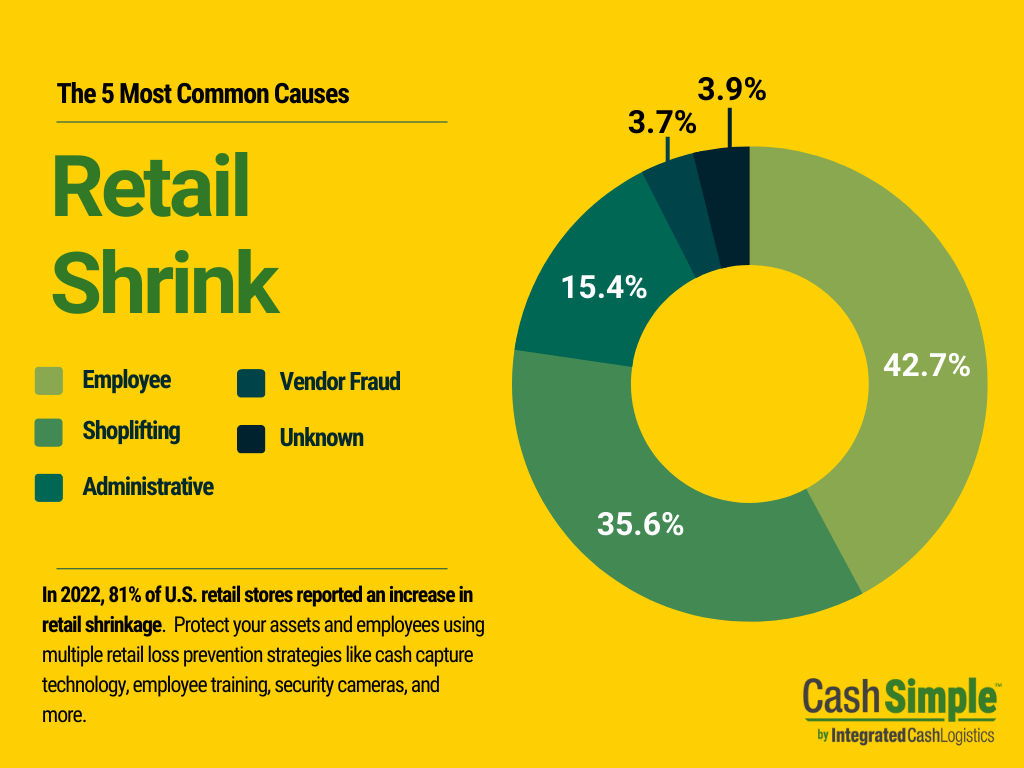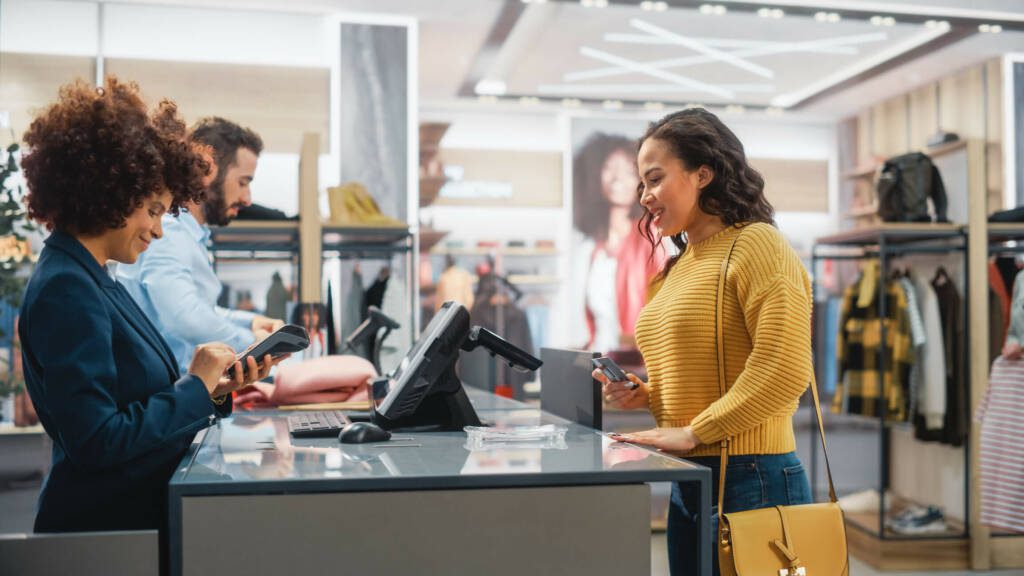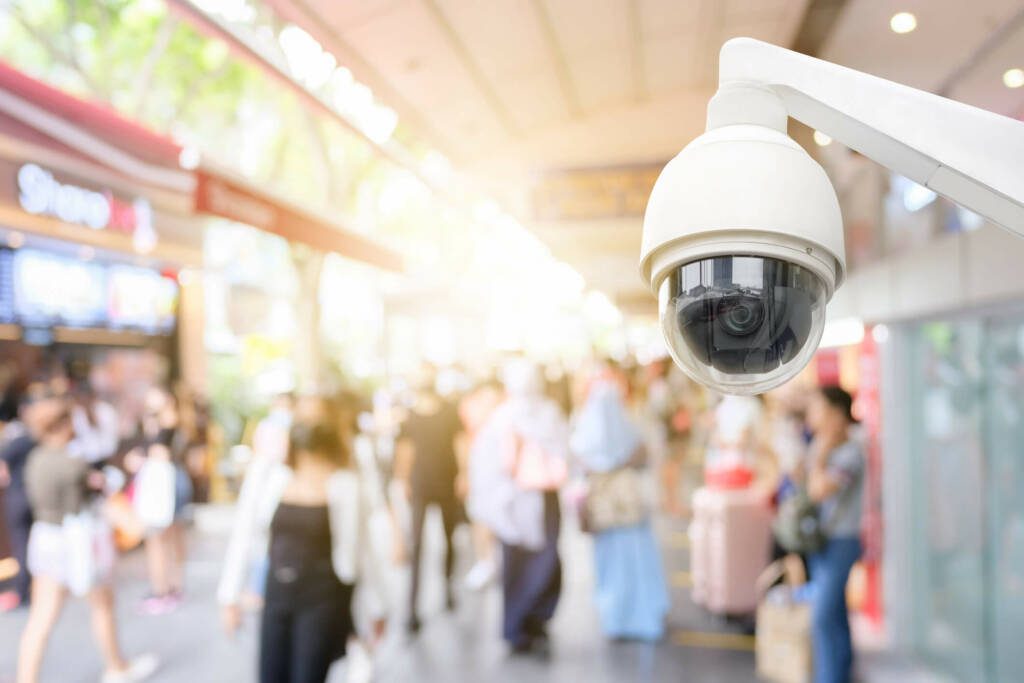The retail world is constantly evolving to include more shopping opportunities for consumers. However, this unfortunately means that there are more opportunities for retail loss. Retail loss prevention is imperative for any store to implement to keep their inventory safe.
In 2022, 81% of U.S. retail stores reported that their shrinkage increased. While no store can ever completely eliminate retail loss, employing active retail loss prevention strategies can help prevent losses and increase retail asset protection. These 16 tips can help you to prevent loss and mitigate internal shrinkage.

Source: ShipBob
From change orders to reconciling deposits, CashSimple™ shortens your distance to cash.
What is Retail Loss Prevention?
Retail loss and prevention is any strategy that businesses employ to help reduce shrinkage. Shrink in retail can occur due to:
- Shoplifting
- Internal theft
- Inventory loss
- Operational errors
- Human error
- Damage to merchandise
Essentially, shrinkage in retail is anything that occurs to make you lose inventory for a reason other than actual sales. It is a growing problem in the retail industry, with stores across the nation losing over $45 million a day due to shoplifting alone.
No matter how shrinkage occurs, creating effective retail store operations and a loss prevention policy can help protect your business from losing out on your bottom line.
Why is Loss Prevention Important?
Beyond working to decrease loss prevention in retail, loss prevention is important in many other ways as well. It’s more than just revenue loss – shrinkage can hurt your business’ brand reputation and the overall safety of your employees and customers as well. Integrating loss prevention tips techniques, such as better cash handling practices, can help ensure your business stays as safe and lucrative as possible.
Different Types of Retail Loss
Various types of loss can affect your business. This can happen both digitally and in physical stores, which can make it even more difficult to keep track of. There are various ways that businesses can work to reduce retail loss, such as implementing cash-capture technology into their business plan.
However, it’s still important to know the types of retail loss so that you can keep track of your inventory and know what areas you may need to implement a loss prevention department. The most common types of retail loss include:
- Internal Theft or Fraud: Internal theft occurs when employees intentionally cause internal shrink by theft, waste, or not reporting inventory or sales accurately. This can be difficult to keep track of, as many employees know how to trick the system into not getting caught.
- External Theft, Shoplifting: External theft, most commonly known as shoplifting, is when customers steal inventory. Implementing loss prevention security can help counteract shoplifting. This has also increased in recent years due to a shortage of retail employees.
- Return Fraud: This occurs when customers buy an item with the intent to immediately return it or use duplicate receipts to get more money back than what they used to pay for it.
- Vendor Fraud: This occurs when a vendor or a supplier is deceptive or dishonest with a business. There are a few ways that vendor fraud can occur including overbilling, submitting false or inaccurate invoices, providing lower quality products or delivering fewer products than ordered.
- Natural Disasters, Fire, Other Accidents: This is an instance where a loss prevention system can’t always help reduce shrinkage. Natural disasters or fires can damage merchandise beyond repair, meaning that businesses lose that inventory.
- Administrative/Clerical Errors: Human error accounts for about 15% of all loss prevention retail shrinkage. This occurs when inventory is inaccurately counted or taken out of the system. It can also occur when there is an accounting issue.

Integrated Cash Logistics real-time reporting and cash-capture technology keeps you with customers instead of in backrooms.
Retail Loss Prevention Strategies
If you have noticed retail shrinkage at your business, or simply want to reduce the possibility of it happening, there are various ways to prevent theft that you can utilize to help increase retail store security and reduce shrinkage.
Depending on the areas where you notice shrinkage the most, you may decide to implement strategies in your store’s policies, technology or software systems, or employee training and security. Overall, the meaning of loss prevention will look different from store to store. Some common changes you can make to help with retail loss prevention include:
- Store Policies and Procedures
- Technology and Software
- Employee Training and Education
- Customer Policies
- Floor Layout and Design
Businesses need efficient cash flow management services if they want to stay ahead. Discover the Integrated Cash Logistics difference.
Store Policies and Procedures
Managers can make changes to store policies to prevent retail loss. One of the best ways to start making changes is to first create a loss prevention audit. This will help you see which areas see shrinkage the most.
Then, managers can make changes and incorporate strategies such as retail loss prevention training for their employees. There may be areas where your employees don’t know the proper procedures, and training can help decrease human error or other issues.
Store Safety and Security
Increasing overall store security can help decrease shoplifting or internal theft. This can include hiring security officers, installing security cameras, or training employees to notice signs of suspicious customers. This can help increase safety for your staff and customers while making sure your inventory doesn’t go missing.
Cash Handling Best Practices
Cash management is imperative for reducing overall shrinkage. Businesses can install cash-capture technology into their everyday practices to ensure that cash and coins are accounted for. Also, loss prevention training ideas such as using fraud markers to check illegal bills, can help ensure the correct amount of cash stays in the till and customers don’t walk away with more than they should.
Shipment and Delivery Policies
Inventory can also go missing as it’s being delivered to or shipped out of the store. Is inventory scanned out of the system when someone places an online order? Do delivery drivers deliver the entire shipment? Implementing more rigorous shipment policies can help mitigate shrinkage during these processes.
Damaged Merchandise
Damaged merchandise is almost inevitable in any business. Whether a customer drops and breaks an item or the item arrives at the store damaged, ensuring that the merchandise is accounted for is imperative. Some damaged merchandise can be sold at a discount, while others will have to be taken out of the system. Changes in store policy to account for these items are important to help reduce retail loss.

Consider outsourcing cash management so that retail operators can focus on running the store.
Technology and Software
With the world becoming more technological by the second, it can be difficult to keep up with the new inventory and POS systems that retail businesses need to utilize. However, finding an effective POS and inventory management system can make all the difference in your business shrinkage.
There are multiple ways that managers can make changes to technology in everyday business practices. Smart technology can help take some of the human error out of the shrinkage process and increase your bottom line.
Cash Capture Technology
Cash capture technology can help businesses reduce the complexity of cash handling. Integrated Cash Logistics makes the process even simpler. We buy your cash as soon as you put it in the safe. We also provide other services that set us apart from other traditional safe companies, such as:
- Arranging cash pickup services
- Eliminating the liability that comes with holding cash
- Minimizing opportunities for cash shrink and theft
- Offering a personalized, configurable portal
The ICL difference can help ensure your business reduces shrinkage.
POS Systems and Inventory Tracking
A POS system, or Point of Sale, is an imperative part of any retail business. However, this is also an area where shrinkage can easily occur, especially due to internal theft or human error. Integrating training for employee loss prevention for your Point of Sale system can help you make sure that your employees know how to handle the POS correctly and efficiently. This can also help prevent issues with inventory tracking.
Security Cameras and CCTV
One of the best ways to help decrease theft or shoplifting is by installing security cameras. You should install these in areas where you’ve noticed the most amount of theft or near areas with more valuable merchandise. You can also put signs warning customers that you have security cameras set up. This type of retail security and loss prevention helps your customers know that they shouldn’t attempt theft, therefore decreasing overall shoplifting limits as well.

Regular safes only keep cash secure. Find out how Integrated Cash Logistics CashSimple™ solution does more to manage your money.
Employee Training and Education
Integrating staff members through employee training and education is imperative for decreasing retail shrinkage for your business. If your employees know how to handle the inventory system, POS system, and other important business tools, your store will see less overall loss.
Employee training can consist of many practices. Whether it’s the manager taking on more training responsibilities or the floor manager keeping track of employee questions and areas for improvement, businesses can make sure they are on top of their employees’ education.
Loss Prevention Training
One way to help train employees in retail loss prevention is by letting them know how it can affect them as well. If there’s enough shrinkage, this can reduce overall profits which can impact employee hours, pay increases, or promotions. Letting them know that they need to be vigilant can make all the difference in how they notice and handle potential shrinkage.
Greeting and Assisting Customers
It sounds simple, but even a simple greeting for customers walking into the store can help prevent shoplifting. This signals to shoplifters that staff is aware they’re in the store and paying attention. Alternatively, greeting and helping customers is just good customer service and a great way to improve customer satisfaction by showing you care about them. This improves their experience and helps build your brand image and outreach.
Cash Handling Best Practices
While better cash handling practices can be integrated on all levels, making sure that employees know how to correctly handle money, audit the registers, and record any discrepancies can help you keep track of the day-to-day operations of each register. This helps you look at potential shrinkage on a much more detailed level than looking at quarterly or annual reports.
Monitoring Suspicious Behavior
Many stores can train employees in monitoring any suspicious behavior from customers and fellow employees as well. If someone is loitering or acting nervous, employees can keep a close eye on them. However, it’s important to keep your employees safe too – make sure they know not to chase or apprehend shoplifters, especially if they leave the store, as this could be dangerous. They should instead notify security personnel who are trained to handle these situations safely.

Learn and implement the best retail cash handling procedures for your business.
Customer Policies
There are also several ways that retail stores can reduce customer and external theft. It’s important that your customers know that they will be responsible for their actions if they attempt to commit theft.
You can post signs around the store reminding customers of your business’ policies. This can help deter them from any potential shoplifting while also reminding them of other rules. A few other ideas include:
Return and Exchange Policies
Return and exchange policies can help you keep track of inventory and it exits and returns the store. While this helps on an overall level of keeping track of your inventory for legal returns and purchases, it also can help deter individuals from return fraud. Make sure your return policies are easy to find for customers, such as posting signs near the registers or printing them on the bottom of a receipt.
Fitting Room Policies
Many stores have fitting room policies that can help them deter shrinkage. Many customers will take clothes into the fitting room and only return some of them to the floor or attendant. Some ways to combat this include putting security tags on your clothing, only allowing one person in at a time, or keeping track of how many items each customer takes into the fitting room and ensuring they return the same amount.

Whether you manage one location or thousands, Integrated Cash Logistics transforms how your business controls cash.
Floor Layout and Design
The store layout can also affect overall shrinkage amounts. If you have areas of the store that employees can’t see easily, this may encourage potential shoplifters to visit those areas more, especially if they have valuable merchandise.
There are many other ways to incorporate effective layout and design aspects to ensure your store reduces overall loss or shrinkage that is due to shoplifting or organized theft.
Minimize Blind Spots
Blind spots can be difficult to manage, as it often depends on the structure of your store. Depending on the space you have, you can minimize blind spots by putting decorative displays in those areas or by implementing video cameras where the blind spots are unavoidable. This can help take some of the stress off your staff when it gets busy as well.
Keep Most Valuable Items Close to Register
It’s easier for employees and managers to keep track of more valuable or expensive items as long as they’re close to the register. This can also deter shoplifters from taking these items, as they know that they’re more likely to get caught by employees.
Employee Responsibilities and Sections
Your employees are one of the best assets you have to help prevent retail loss. If you know that the store is going to be busier around the holidays, it may be best to have more people on shift. You can also ensure that there is always someone on the register or greeting customers. Retail loss prevention can be minimized by making sure your staff isn’t overwhelmed by customers.
Spend Less Time in Backrooms and Prevent Loss With Integrated Cash Logistics CashSimple™
One of the best loss prevention techniques is to implement Integrated Cash Logistics’ CashSimple™ technology. We make controlling your cash easy, by using our proprietary software to simplify your daily cash practices.
We can streamline your change orders, provide auto refills and counts, and deliver real-time reporting. This can help you keep track of your daily shrinkage and ensure your cash-handling practices stay effective and protected. Get in touch with Integrated Cash Logistics today to see how we can help you with retail loss prevention. We can help you set up a demo for your store so you can see just how we can support you.
